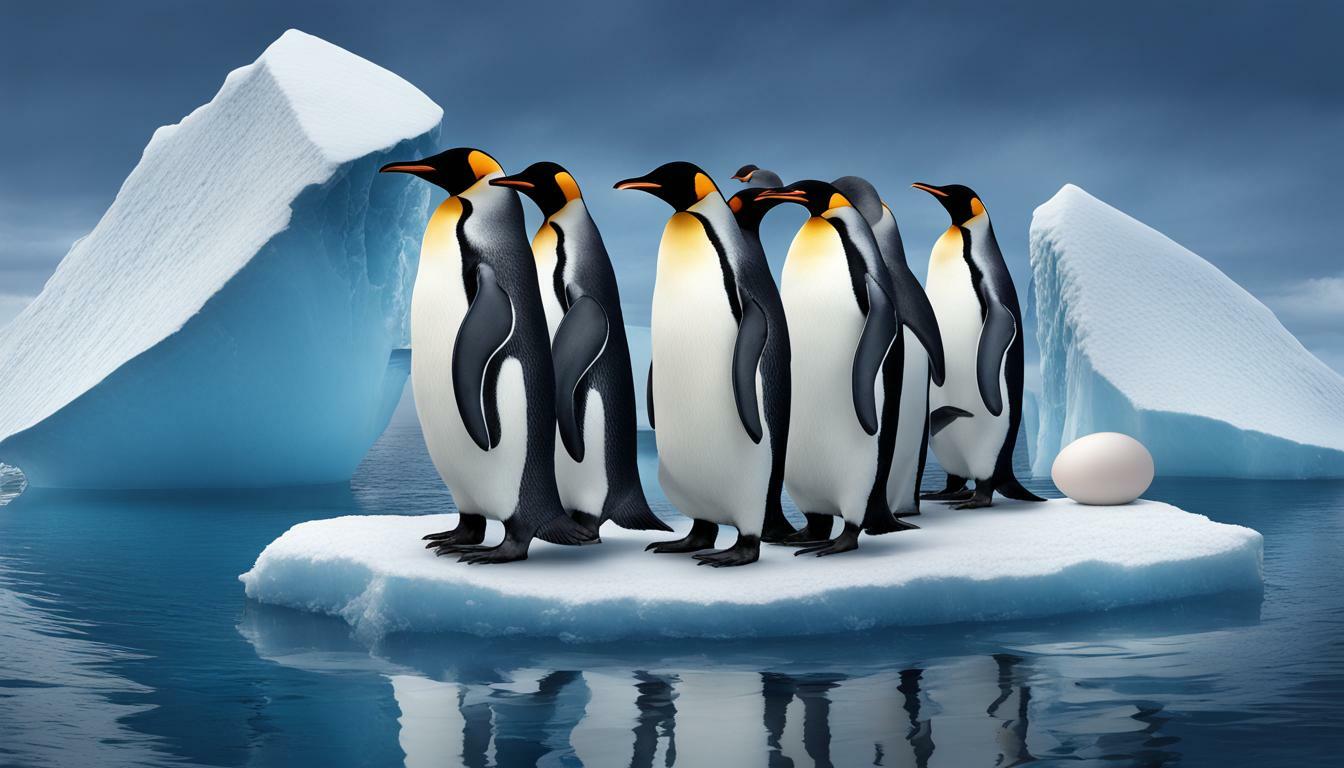When it comes to animal reproduction, penguins may not immediately come to mind as a species of interest. However, these flightless birds have some fascinating reproductive habits that are worth exploring. You may be wondering, “Do Penguins Lay Eggs?” The answer is yes, and in this section, we will dive deeper into penguin reproduction to learn more.
Key Takeaways:
- Penguins do lay eggs.
- Understanding penguin reproduction requires exploring their nesting habits, breeding cycle, egg-laying process, chick development, parenting behavior, and reproductive biology.
- Each aspect of penguin reproduction plays a crucial role in the survival of these amazing birds in their icy habitats.
Penguin Nesting Habits and Breeding Cycle
Now that we know that penguins lay eggs, let’s explore their nesting habits and unique breeding cycle. Penguins are known for their strong pair bonds and commitment to their offspring.
The breeding season for penguins typically begins in the austral summer, from October to February. During this time, they gather in large colonies to mate and nest. The nesting process usually begins with courtship rituals, which include vocalizations, displays, and physical touch between pairs. After mating, the female penguin will lay her eggs, usually one or two, and the male will take over incubation duties while the female goes to the sea to feed and replenish her reserves.
Incubation can last from around 30 to 60 days, depending on the species, during which time the male will remain on the nest, fasting and protecting the egg(s) from predators and the harsh Antarctic weather. Once the eggs hatch, the male and female take turns feeding and caring for the chicks until they are strong enough to go to sea-some species even form day-care groups to leave the chicks while the parents go out to feed.
Penguin Nesting Habits
Each penguin species has its unique nesting habits. Emperor penguins, for instance, incubate their eggs on their feet, with a warm brood pouch of feathered skin, while rockhopper penguins prefer to nest on rocky ledges. Gentoo penguins, on the other hand, construct nests out of pebbles and stones. Adélie penguins build their nests out of stones and place them on a flat rock ledge for better drainage. Some species will even move their nests several times in a season to avoid flooding or snowfall.
Penguin Breeding Cycle
The complete breeding cycle for penguins can take several months. Once the chicks have fledged, the adults return to sea to feed and build up their fat reserves. They will then molt their old feathers and grow new ones, a process that takes about three weeks. After molting, they will return to the sea and begin feeding again, starting the cycle anew. Penguins are truly remarkable and fascinating creatures, adapting to harsh conditions and evolving unique reproductive strategies to ensure their survival.
The Egg-Laying Process: Do All Penguin Species Lay Eggs?
Penguin reproduction is a fascinating field of study, and one question that often arises is whether all penguin species lay eggs. The answer is yes, all penguin species lay eggs.
The egg-laying process is a critical stage in the breeding cycle of penguins. The exact timing of egg-laying varies by species, but it generally occurs in the winter months when temperatures are the coldest and food is the most abundant. Female penguins typically lay one or two eggs, which are the largest eggs relative to body size of any bird species.
During egg-laying, male and female penguins take turns incubating the eggs, with the duration of each incubation shift varying by species. Emperor penguins, for example, have the longest incubation shift of any bird species, with males incubating the egg for up to two months while females go to sea to feed.
The egg-laying process is a critical step in ensuring the survival of penguin species. While all penguin species lay eggs, there are some variations in the size, shape, and color of eggs among different species. Additionally, some species may also exhibit unique behaviors during egg-laying, such as communal nest-building or egg-stealing.
In conclusion, all penguin species lay eggs as part of their reproductive cycle. The egg-laying process is a critical stage in ensuring the survival of penguin populations, and it provides a fascinating glimpse into the unique adaptations and behaviors of these remarkable birds.Penguin Chick Development and Parenting Behavior
Penguin chicks undergo a remarkable growth journey in the harsh Antarctic environment. They hatch from eggs that their parents have incubated for up to two months, and initially, they are covered with downy feathers that protect them from the cold. Over time, the downy feathers are replaced by waterproof adult feathers that enable them to swim and dive for food.
During the chick-rearing period, both male and female penguins exhibit unique parenting behaviors. They work in shifts to protect their chicks from predators, regulate their body temperature, and provide them with food. Emperor penguin fathers, for instance, cradle their chicks on their feet and cover them with a flap of abdominal skin to protect them from the cold.
As the chicks grow, they form “creches” or groups with other chicks, providing them with a social environment to interact, learn and practice skills, such as preening feathers or swimming.
Understanding Penguin Reproductive Biology
If you’ve ever wondered about the science behind penguin reproduction, this section is for you. Penguin reproductive biology is a complex and fascinating subject that involves a variety of physical and hormonal processes.
Penguins have evolved unique adaptations that allow them to survive and reproduce in their harsh environments. They have a variety of reproductive strategies and behaviors that have been shaped by millions of years of evolution.
One of the most interesting aspects of penguin reproduction is their mating behavior. Penguins are known for their elaborate courtship rituals, which involve a variety of vocalizations, displays, and physical interactions. These behaviors are designed to help penguins identify and choose the best mate for breeding.
Once a pair of penguins has formed a bond, they will engage in copulation. Penguins have a unique reproductive anatomy that allows them to transfer sperm from the male to the female without the need for physical contact. This adaptation helps to reduce the risk of heat loss during breeding.
After fertilization, the female penguin will lay one or two eggs, depending on the species. The eggs are typically laid in a nest made of stones, sticks, or other nesting materials. Both male and female penguins take turns incubating the eggs, with each partner spending several days at a time on the nest.
During the incubation period, the eggs are kept warm and protected from the cold. Penguin parents have a variety of strategies for keeping their eggs safe, including using their brood pouch to insulate the eggs from the cold and fending off predators.
After the eggs hatch, the chicks begin a period of rapid growth and development. They rely on their parents for food and protection, and both male and female penguins take turns caring for the young.
Overall, the reproductive biology of penguins is a complex and fascinating subject that offers insights into the unique adaptations and behaviors of these amazing birds.
Conclusion
Congratulations, you now have a comprehensive understanding of penguin reproduction! We have explored their unique nesting habits, breeding cycle, egg-laying process, chick development, parenting behavior, and reproductive biology.
You now know the answer to the question “Do Penguins Lay Eggs?” – the answer is yes! We have also discovered that penguins have fascinating reproductive strategies that contribute to their survival in their icy habitats.
Keep exploring and learning about the incredible world of penguins!
Are Chicken and Penguin Eggs Similar in Terms of Upsetting the Animals?
The chickens’ emotional response to egg removal varies, but it is safe to say that chickens, unlike penguins, may become upset when their eggs are taken away. Although both chicken and penguin eggs are important for their respective species, the impact on the animals’ emotional state differs.
FAQ
Q: Do penguins lay eggs?
A: Yes, penguins do lay eggs. It is a vital part of their reproductive process.
Q: What are the nesting habits of penguins?
A: Penguins build nests on land, usually using rocks or pebbles. They create nests in colonies, often in tight-packed spaces to provide protection and insulation.
Q: How long is the breeding cycle for penguins?
A: The breeding cycle for penguins varies among species, but it generally takes several months. It involves courtship rituals, mate selection, egg-laying, and incubation periods.
Q: Do all penguin species lay eggs?
A: Yes, all penguin species lay eggs. It is a characteristic shared by all penguins.
Q: What is the egg-laying process for penguins?
A: When it is time to lay eggs, female penguins produce an egg. Both male and female penguins take turns incubating the egg to keep it warm and protected until it hatches.
Q: How do penguin chicks develop?
A: Penguin chicks hatch from eggs and go through a growth process in which they develop feathers, gain weight, and become more independent. They rely on their parents for food and protection during this time.
Q: What is the role of penguin parents in chick development?
A: Penguin parents play a crucial role in nurturing and protecting their chicks. They provide warmth, food, and guidance until the chicks are strong enough to fend for themselves.
Q: What is the reproductive biology of penguins?
A: Penguin reproductive biology encompasses the anatomy, physiology, and behaviors involved in the reproductive process. This includes mating behaviors, fertilization, and the hormonal mechanisms that drive penguin reproduction.










